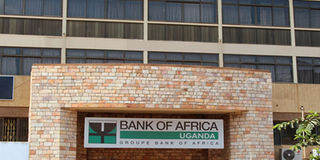Prime
Bank of Africa Uganda taps cash from parent company

A Bank of Africa branch in Kampala. The bank will have enough cash to expand its loan book beyond Shs468 billion it had in 2022. PHOTO | FILE
What you need to know:
The Bank of Africa Group SA proposed to recapitalise its subsidiaries in countries that are part of the International Development Association.
A tight economy for financial institutions, characterised by high capital requirements, high credit demand, and high default loans, has compelled several of them to obtain additional funds for their cash pool to expand their lending services.
The World Bank Group’s private investment arm, the International Finance Corporation (IFC) revealed late last month that it has provided a concessional loan to the Bank of Africa Group SA, the company that owns Bank of Africa (BOA) Uganda, to support the lending services of its subsidiary banks.
With the economy recovering from a lockdown-induced slowdown that stalled trade and several economies, the $171.2 million in funding is intended to increase lending to small and medium sized businesses (SMEs) whose demand has been on a frenzy for the past three years.
This money, according to the IFC, is to a project that the Bank of Africa Group SA proposed to recapitalise its subsidiaries in countries that are part of the International Development Association (IDA) and in fragile and conflict-affected situations.
The affiliates are nine financial institutions: Bank of Africa Uganda, Bank of Africa Benin, Bank of Africa Burkina Faso, Bank of Africa Cote d’Ivoire, Bank of Africa Kenya, Bank of Africa Mali, Bank of Africa Niger, Bank of Africa Senegal, and Bank of Africa Togo.
“The facility will support the group in scaling up its lending to micro, small, and medium enterprises (SMEs) in the context of high interest rates which led to tightening liquidity in the region,” the IFC stated in a disclosure.
By proving that lending to SMEs is commercially viable, the global financier aims at encouraging increased competition in the SME finance market.
SMEs are defined as businesses with 10–300 employees and assets between $100,000 (Shs378m) and $15 million (Shs57 b), according to IFC data, which stated, “for all entities except for BOA Uganda, the project will be processed under the Base of the Pyramid (BOP) programme,” IFC stated.
The BOP programme which typically focuses on providing financial services and support to individuals and businesses at the lower end of the income pyramid, aims at promoting inclusive economic development.
According to data in its financial statements, BOA Uganda will now have enough cash to expand its loan book beyond Shs468 billion that it had in 2022, to bolster its annual return on assets and equity, which has been declining by margins of more than four percent.
The local lender was forced to deplete its resources and share premiums to meet the Bank of Uganda’s Shs150 billion core capital requirement, up from Shs47 billion. Bank of Uganda and the National Treasury embarked on this move to protect local banks from economic headwinds.
Three banks had not met the Shs150 billion core capital requirements by December 2023.




